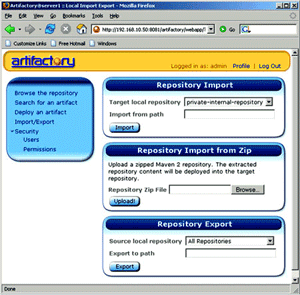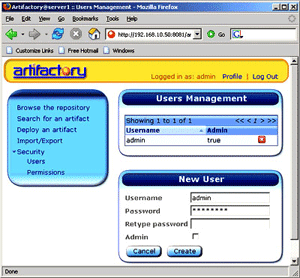|
|
Building Projects: Learn to Set Up A Maven2 Repository
|
|
|

3 Once uploading is complete successfully,
the artifact along with the ‘pom.xml’ file
created by artifactory appears in the
repository.
Installing artifacts from maven command
line:Using the command 'maven clean
install' maven only packages and installs
the artifact to the local repository. We need
to add the additional configuration section
in the settings.xml file to install it to the
local internal repository. Steps involved in
whole of the process are shown below:
settings.xml
<settings>
<servers>
<server>
<id>organisation-internal</id>
<username>admin</username>
<password>password</password>
</server>
</servers>
</settings>
| |
The command given below is used to install
an artifact to internal maven repository.
mvn deploy:deploy-file -
DrepositoryId=organisation-internal -
Durl=http://localhost:8080/artifactory/
private-internal-repository-DgroupId=
test -DartifactId=test -Dversion=
1.1 -Dpackaging=jar -Dfile=target/test-
1.1.jar
Both the repository id and the server id
defined in the settings.xml should be same.
The url should include the repository name
to which the artifact is to be installed. The
artifactory and the new artifacts appeared
in the repository creates the 'pom'
(pom.xml) file for us automatically.

VIII. Other Artifactory features:
* Backup the repository: Backup policy
is specified in the <ARTIFACTORY_INSTALLATION _FOLDER>/
etc/artifactory .config.xml and 'cron'
expression specifies the backup
configuration. Backup configuration is
shown below: |
|
Sept 2007 | Java Jazz Up | 33 |
| |
|
| |
Pages:
1,
2,
3,
4,
5,
6,
7,
8,
9,
10,
11,
12,
13,
14,
15,
16,
17,
18,
19,
20,
21,
22,
23,
24,
25,
26,
27,
28,
29,
30,
31,
32,
33,
34,
35,
36,
37,
38,
39,
40,
41,
42,
43,
44,
45,
46,
47,
48,
49,
50,
51,
52,
53 ,
54,
55,
56,
57,
58,
59,
60,
61,
62,
63 ,
64,
65 ,
66 ,
67 ,
68 ,
69 ,
70,
71,
72,
73,
74,
75,
76,
77,
78,
79, Download PDF |
|
|
|
|
|
|
| |
| |
|